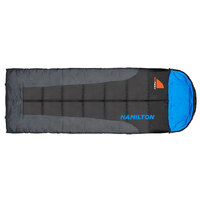What is a Winter Sleeping Bag?
Winter Sleeping Bags are sleeping bags rated to a cold temperature. Most winter sleeping can be one that is advertised with a comfort rating of 0° or below. However, the key consideration with selecting any sleeping bag including a winter sleeping bag is how you will be using the bag for most of the time rather than buying a sleeping bag for that once off time in the snow or in an extreme situation.
Most people tend to buy a sleeping bag with a temperature rating much lower than what they need for the majority of it’s use, often the user is too hot, and the sleeping bag is not used to its full potential. In some cases, people may purchase 2 sleeping bags, one for winter use and the other for summer/in-between seasons. But the reality is, that most people can’t afford to purchase two sleeping bags, or they don’t have room in their caravan, RV, or camper trailer to cart around a sleeping bag that doesn’t even get used for 6 months of the year.
Here at Bundy Outdoors, we would recommend buying a sleeping bag that suits your needs for 90% of the time. And if you are unable to purchase a second sleeping bag, then workout the best way to “value add” to your existing sleeping bag, whether that is a fleece sleeping bag liner or sleeping in thermal clothes, layering clothes or a combination of all three.
How does a sleeping bag work?
A sleeping bag is an insulator, and its primary role is to prevent heat from your body transferring into the night air. A sleeping bags’ internal fill swells and traps heat in and around the fibres as it is emitted from you body essentially creating a cocoon of warm air around your body. Regardless of if it’s a down sleeping bag or a synthetic sleeping bag, they all work the same way.
One thing to remember is that to effectively work the sleeping bag fibres must be allowed to swell and trap body heat, if they can’t expand, they can’t provide sufficient insulation. So, if you are cold and need to use a blanket for additional warmth, put it on the inside of the sleeping bag, not the outside. A blanket or something heavy placed over the top of the sleeping bag will prevent the fibres from trapping heat properly.
What size sleeping bag do I need?
Another consideration is sleeping bag size. A large sleeping bag for a small person will not work as effectively as there is just “too much” empty space for your body to create enough warm are to fill all those areas, and the came can be said for a double sleeping bag.
If you have purchased two sleeping bags that can be zipped together to form a double sleeping bag and you find your self in a situation where you are still cold even sleeping with someone beside you, try un-zipping them and using them separately, there will be less empty space within a single sleeping bag to fill.
And anyone who’s ever shared a bed and participated in a late-night tug-of-war with the doona, sometimes what is the goldilocks zone for one person can be a sweaty night-long marathon for the other. Like shoes, a sleeping bag is not a one-size-fits-all situation. At the end of the day, a sleeping bag should fit like the proverbial “snug as a bug in a rug”. With enough room to shuffle around to find your comfy spot, but not so big that you are swimming in it.
What else do I need to Consider when buying a cold weather sleeping bag?
Further consideration should be given to how you will use your sleeping bag most of the time. If you are in a swag for example, there is very little excess room around you while sleeping meaning the smaller the space the warmer it can be. But if you are in a huge roomy tent there is too much excess space and a tent doesn’t always offer the best insulation from the outside weather, so you will find you will be colder.
And obviously packed size and weight are always going to be a factor in purchasing a sleeping bag. You can’t really carry a huge canvas sleeping bag around that weighs 6kg or more when you are hiking. Luckily as time goes on and technology develops sleeping bag are getting smaller and lighter while still providing fantastic insulative properties.

